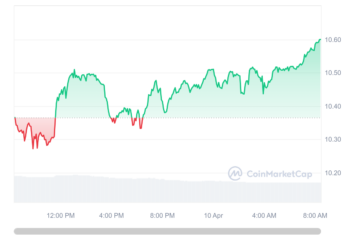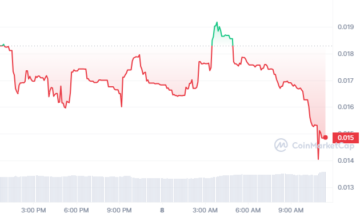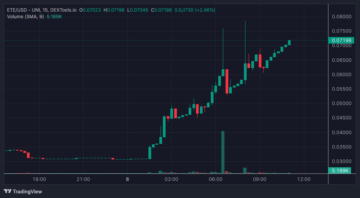
Join Our Telegram channel to stay up to date on breaking news coverage
A novel Bitcoin mining project is ready to launch in Northeast Pennsylvania. Terawulf is setting up a mining plant fueled by nuclear energy called Nautilus.
Terawulf first said in 2021 that Nautilus’ fleet of 15,000 mining machines will have a hash rate of 1.6 exahashes per second (EH/s) when it reaches full capacity later in Q1 of this year.
It is equivalent to 1.6 quintillion hashes per second, or around 0.54% of the present processing power of the whole Bitcoin mining network, which is operating at a speed of 294.09 EH/s.
Yet, more crucially, none of this new mining power will come from fossil fuels, possibly resolving a long-standing critique of the most popular cryptocurrency.
A proof-of-work (PoW) mining method is used by Bitcoin to verify transactions and protect the network. Now, miners—computers designed for confirming transactions and earning Bitcoin—consume around 117 terawatt hours annually, or almost as much energy as a small nation.
As miners continue to deploy upgraded equipment and even entirely new fleets, this statistic doesn’t appear to be slowing down anytime soon.
Hash rate, which measures the amount of processing power needed to mine Bitcoin globally, has been steadily increasing since 2016.
This chart is being observed by more people than only miners. Regulators are also taking notice since around 62% of the energy mix used to power all those devices today comes from fossil fuels.
Only last year, the state of New York passed a law prohibiting the establishment of any new fossil fuel-powered Bitcoin mining operations within its borders for two years. Similar legislation aimed at proof-of-work (PoW) mining was also presented to European parliamentarians, who soundly rejected it.
Nazar Khan, co-founder, CTO, and COO of Terawulf, responded to an inquiry made by publication Decrypt about whether he was concerned about a governmental crackdown on PoW-based mining by saying that he hoped “they consider feedback from folks like ourselves.”
Terawulf aims to promote eco-friendly Bitcoin mining
Terawulf advertised itself as a “leading sustainable Bitcoin mining firm” when it was founded in 2021 by Nazar Khan and Paul Prager, who were senior executives of Beowulf, an energy infrastructure business that Prager had founded in 1990.
Khan had already spent more than twenty years creating and managing power-generation facilities both domestically and internationally when he started learning more about cryptocurrency in 2017.
In his early days of networking with miners, Khan writes,
As I started to understand how Bitcoin mining worked, it was evident to me that efficient and economic Bitcoin mining was greatly dependent on infrastructure and the cost of electricity.
In an interview with Decrypt, he said,
Pick the name of a Bitcoin miner and I’ve certainly talked to them at some time, trying to find a way to work together. Well, I know electricity and I know energy. Let me find someone who knows Bitcoin mining. I quickly saw how low the degree of sophistication was in the area of energy, energy development, and energy buying.
Khan’s crew had already finished building a sizable facility for Marathon, one of the biggest mining firms in the world, a year before establishing Terawulf.
The energy business Talen, whose subsidiary Cumulus Data had constructed a data center next to the parent company’s 2.5 gigawatt Susquehanna nuclear power station to house Bitcoin mining activities, called after this partnership. Nautilus was so created.
When you combine Nautilus’ statistics with Terawulf’s planned 3.8 EH/s capacity at its hydroelectric Lake Marina plant in western New York, it becomes evident that the company will have one of the largest Bitcoin mining facilities in the world that is fueled nearly entirely by renewable energy.
Yet it involves more than just crypto miners taking advantage of cheap, clean electricity.
Khan discussed how Talen’s excess renewable electricity can be reliably used by businesses like Nautilus and Lake Marina while also serving as responsive assets for local electrical grid operators thanks to the Terawulf team’s extensive knowledge in energy infrastructure.
The term “asset” broadly refers to mining farms that are advantageous to have on a grid and intangible assets to energy providers, offering high customer lifetime value (CLV) thanks to their advantageous locations that can keep energy prices low. CLV is the value derived from having consistent, dependable customers.
Location, location, location
The parent business of Beowulf, Riesling Power LLC, acquired a closed coal plant in Somerset, on the western border of New York State, in 2016.
The plans for new coal plants worldwide were reduced by 76% as a result of the Paris Agreement, which had been signed in New York City the year before. The group realized they were effectively purchasing the facility to shut it down.
Using a network of transmission lines—those thick cables you see supported by massive towers along international highways—the facility was linked into the state grid. Transmission lines were set up to transfer 700 megawatts of power from the plant to the grid when it was in operation.
Khan realized Terawulf could just as easily bring 700 megawatts of power into the location to fuel a fleet of Bitcoin miners due to his professional knowledge in energy infrastructure.
Khan then started looking for energy for the site and discovered that the local grid zone (Zone A), which is overseen by a non-profit organization known as the New York System Independent System Operator (NYISO), produces “about four to five gigawatts” of power using primarily renewable sources, such as hydroelectric power.
Terawulf’s first Bitcoin mine, Lake Marina, was up and running by March 2022.
Local demand only uses “a gig or a gig and a half” of those five gigawatts, leaving more than three gigawatts of excess generation to be transported by transmission lines across the state, primarily to meet the energy needs of the Big Apple, also known as the “New York City load pocket” in the power industry.
For mining operations to be effectively placed, local energy demands must be understood. Massive electricity loads placed in high-demand locations will likely result in higher costs than they now are.
Khan said, “One of the most effective and affordable load drains out there is bitcoin mining. We are placing our loads in areas with high power supply and low demand so that we may operate as a “sink” to absorb energy at competitive costs and provide a means of selling electricity in areas where there are generally few buyers.
Location is crucial, but for renewable energy even more so. Hydroelectric and nuclear power plants never cease producing electricity, and these facilities can occasionally keep going for years at a time.
However, having too much energy may be hazardous for a system in the same way that not having enough energy can result in rolling blackouts, as was the case in Texas last year.
Herein lies a further potential benefit of strategically located mining companies.
When there is a high supply of energy or a strong demand for it, they may quickly shut down machinery or skim extra energy from a grid.
Grid operators are amazed
According to Khan, the grid only meets peak demand for 50–100 hours a year despite being built to do so plus a buffer.
Terawulf’s mines—and Bitcoin mines in general—can lower their demands in seconds if the grid gets too hot, but that’s usually not a concern for a mining farm sucking up copious renewable energy in a low-demand location.
This is made possible by a mechanism available to grid operators called Automatic Generation Control (ACG). To maintain a balance between local production (the amount of power generated) and local electrical load in a specific section of the grid, ACG modifies the output of generators at various power facilities (the power consumed).
According to Khan, if a grid operator needs to add 15 or 25 megawatts to a region where the load is constrained, they will notify a power plant in a region with extra capacity to shut down. In other words, when operators need to increase generation in a certain location, they must decrease it elsewhere.
The typical ACG reaction time is 15 minutes, thus it takes a quarter of an hour from the time the grid operators deliver the signal to the plant until the plant reaches its satisfactory level.
The response time for bitcoin mining is closer to fifteen seconds.
When they consider it, “[grid operators’] minds are kind of blown,” claimed Khan. We have a load that responds in 10, 20, 50, or 100 megawatts in less than a minute, and you can ramp it back up in the same amount of time. When operators learn how responsive we can be, they get infatuated with it since that level of responsiveness is unheard of.
A typical top-of-the-line Application-Specific Integrated Circuit (ASIC) or mining machine may be shut off in under a minute, making even a fleet of them more responsive than a nuclear plant. This quick reaction time is the result of this.
The ability of the electric load to respond is unaffected whether the signal to switch off is timed a day in advance or in real time. With the majority of industrial-scale loads, this is not the case.
When seen in this light, miners like Terawulf become less pioneers of environmentally friendly cryptocurrency mining and more of a tool for grid managers to use to maintain a delicate balance between supply and demand.
When there is a surplus of energy, miners may quickly adjust their needs by soaking it up or by shutting off their equipment when there are higher demands elsewhere.
Related
Join Our Telegram channel to stay up to date on breaking news coverage
- SEO Powered Content & PR Distribution. Get Amplified Today.
- Platoblockchain. Web3 Metaverse Intelligence. Knowledge Amplified. Access Here.
- Source: https://insidebitcoins.com/news/nuclear-bitcoin-mining-at-terawulf-is-only-one-piece-of-the-green-mining-jigsaw
- 000
- 1
- 10
- 100
- 2016
- 2017
- 2021
- 2022
- a
- ability
- About
- According
- acquired
- across
- activities
- advance
- ADvantage
- affordable
- After
- Agreement
- aims
- All
- already
- amount
- and
- Annually
- appear
- Apple
- AREA
- areas
- around
- asic
- Assets
- Automatic
- available
- back
- Balance
- become
- becomes
- before
- being
- benefit
- between
- Big
- Biggest
- Bitcoin
- Bitcoin Miner
- Bitcoin Miners
- Bitcoin mining
- border
- Breaking
- breaking news
- bring
- broadly
- buffer
- Building
- built
- business
- businesses
- buyers
- Buying
- cables
- called
- Capacity
- case
- Center
- certain
- certainly
- Chart
- cheap
- City
- claimed
- closed
- closer
- Co-founder
- Coal
- combine
- come
- Companies
- company
- Company’s
- competitive
- Concern
- concerned
- Consider
- consistent
- consumed
- continue
- control
- coo
- Cost
- Costs
- could
- Crackdown
- created
- Creating
- crucial
- crucially
- crypto
- crypto miners
- cryptocurrency
- CTO
- customer
- Customers
- data
- Data Center
- Date
- day
- Days
- decrease
- Decrypt
- Degree
- deliver
- Demand
- demands
- dependable
- dependent
- deploy
- Derived
- designed
- Despite
- Development
- Devices
- discovered
- discussed
- Doesn’t
- domestically
- down
- Early
- Earning
- easily
- Economic
- Effective
- effectively
- efficient
- Electric
- electricity
- elsewhere
- energy
- energy prices
- enough
- entirely
- equipment
- Equivalent
- establishing
- establishment
- European
- Even
- executives
- extensive
- extra
- facilities
- Facility
- farm
- Farms
- feedback
- few
- Find
- firms
- First
- FLEET
- fossil fuels
- Founded
- friendly
- from
- Fuel
- fuels
- full
- further
- generally
- generated
- generation
- generators
- get
- Globally
- going
- governmental
- greatly
- Green
- Grid
- Group
- hash
- hash rate
- having
- High
- higher
- HOT
- HOURS
- House
- How
- However
- HTTPS
- in
- In other
- Increase
- increasing
- independent
- industry
- Infrastructure
- InsideBitcoins
- integrated
- International
- internationally
- Interview
- involves
- IT
- itself
- jigsaw
- Keep
- Kind
- Know
- knowledge
- known
- lake
- largest
- Last
- Last Year
- launch
- Law
- LEARN
- learning
- leaving
- Legislation
- Level
- lifetime
- light
- likely
- lines
- linked
- LLC
- load
- loads
- local
- located
- location
- locations
- long-standing
- looking
- Low
- machine
- machinery
- Machines
- made
- maintain
- Majority
- Making
- Managers
- managing
- Marathon
- March
- massive
- means
- measures
- mechanism
- Meet
- Meets
- method
- minds
- Mine Bitcoin
- miner
- Miners
- mines
- Mining
- Mining Companies
- mining facilities
- mining farms
- mining machines
- minute
- minutes
- more
- most
- Most Popular
- name
- nation
- nearly
- Need
- needed
- needs
- network
- networking
- New
- New York
- new york city
- New York state
- news
- next
- non-profit
- non-profit organization
- novel
- nuclear
- Nuclear Energy
- Nuclear power
- occasionally
- offering
- ONE
- operate
- operating
- operation
- Operations
- operator
- operators
- organization
- Other
- paris
- Paris Agreement
- Partnership
- passed
- Paul
- Paul Prager
- Peak
- Pennsylvania
- People
- piece
- pioneers
- placing
- planned
- plans
- plants
- plato
- Plato Data Intelligence
- PlatoData
- plus
- Popular
- possible
- potential
- PoW
- power
- power plants
- Power Supply
- present
- presented
- Prices
- primarily
- processing
- Processing Power
- Production
- professional
- project
- promote
- Proof-of-Work
- Proof-of-Work (PoW)
- protect
- provide
- providers
- Publication
- purchasing
- Q1
- Quarter
- Quick
- quickly
- Quintillion
- Ramp
- Rate
- Reaches
- reaction
- ready
- real
- real-time
- realized
- Reduced
- refers
- region
- Regulators
- Renewable
- renewable energy
- resolving
- Respond
- response
- responsive
- result
- Rolling
- running
- Said
- same
- Second
- seconds
- Section
- Selling
- senior
- serving
- set
- setting
- Shut down
- Signal
- signed
- similar
- since
- Since 2016
- site
- sizable
- Slowing
- small
- So
- some
- Someone
- Soon
- Sources
- specific
- speed
- spent
- started
- State
- station
- statistics
- stay
- strong
- subsidiary
- such
- supply
- Supply and Demand
- Supported
- surplus
- Susquehanna
- sustainable
- Switch
- system
- takes
- taking
- Terawulf
- texas
- The
- The Area
- The State
- the world
- their
- this year
- three
- time
- Timed
- to
- today
- together
- too
- tool
- Transactions
- transfer
- transported
- typical
- unaffected
- under
- understand
- understood
- upgraded
- use
- usually
- value
- various
- verify
- Western
- whether
- which
- while
- WHO
- will
- within
- words
- Work
- work together
- worked
- world
- worldwide
- wrap
- year
- years
- zephyrnet











